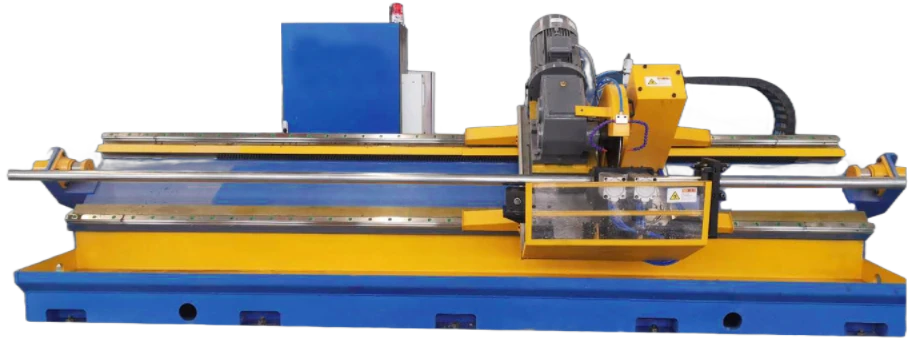extrusion molding machine
Understanding Extrusion Molding Machines A Comprehensive Overview
Extrusion molding is a widely utilized manufacturing process that plays a pivotal role in producing a variety of plastic products. This technique is characterized by its ability to create continuous shapes by forcing molten material through a die, resulting in products such as pipes, sheets, film, and various other components used in countless industries. The heart of this process is the extrusion molding machine, which is essential for transforming raw plastic pellets into usable products. In this article, we will explore the components, working principles, applications, and benefits of extrusion molding machines.
Components of an Extrusion Molding Machine
An extrusion molding machine comprises several key components, each critical to its operation.
1. Hopper The process begins at the hopper, where raw plastic pellets are fed into the machine. The hopper is designed to facilitate a smooth flow of materials into the barrel.
2. Barrel The barrel is a long, cylindrical chamber that houses a rotating screw. This section melts the plastic pellets using both mechanical and thermal energy.
3. Screw The screw plays a vital role in conveying the pellets along the length of the barrel. As the screw rotates, it generates heat and pressure, melting the plastic and mixing it homogeneously.
4. Die Once the material reaches the desired temperature and consistency, it is pushed through a die. The die has a specific shape that defines the final product's cross-section.
5. Cooling System After exiting the die, the extruded product typically passes through a cooling system to solidify and maintain its shape.
6. Cutting/Spooling Unit Depending on the type of product, the extruded material may either be cut into specific lengths or wound onto spools for further processing.
Working Principles of Extrusion Molding
The working principle of an extrusion molding machine can be summarized in several steps
extrusion molding machine

2. Melting and Mixing As the screw rotates, the frictional heat generated melts the pellets. The design of the screw helps in mixing the material for uniformity.
3. Extrusion through Die The molten plastic is then pushed through a die, which shapes the product according to its specifications.
4. Cooling and Solidifying The extruded material moves through a cooling system, which solidifies it into the final shape before it is cut or spooled.
Applications of Extrusion Molding Machines
Extrusion molding machines are versatile and find applications in numerous industries, including
- Construction Producing pipes, fittings, and other components used in plumbing and infrastructure. - Packaging Manufacturing films, sheets, and containers used in food and consumer goods packaging. - Automotive Creating parts such as trims, seals, and conduits for various vehicles. - Consumer Goods Producing everyday items ranging from toys to household appliances.
Benefits of Extrusion Molding Machines
The advantages of using extrusion molding machines are significant
1. Efficiency The process allows for continuous production, leading to high output rates. 2. Cost-Effectiveness Reduced material waste and lower manufacturing costs result from mass production. 3. Design Flexibility Custom dies can be designed to produce a wide range of profiles and shapes. 4. Material Versatility Various thermoplastics and thermosetting plastics can be processed, allowing for diverse product applications.
Conclusion
In conclusion, extrusion molding machines are essential tools in modern manufacturing, capable of producing a vast array of plastic products with efficiency and precision. Understanding the intricacies of these machines provides insights into their critical role in various industries, ultimately driving innovation and meeting consumer demands. As technology continues to advance, extrusion molding is poised to thrive, contributing to both sustainability and advancement in manufacturing practices.
-
High Frequency Straight Seam Welded Pipe Production Line-BzZhou Xinghua Machinery Equipment Manufacturing Co., LTD.|Precision Welding, High EfficiencyNewsJul.30,2025
-
High Frequency Straight Seam Welded Pipe Production Line|BzZhou Xinghua|Precision Welding&EfficiencyNewsJul.30,2025
-
High Frequency Straight Seam Welded Pipe Production Line - BzZhou Xinghua|Precision Engineering&EfficiencyNewsJul.30,2025
-
High-Frequency Straight Seam Welded Pipe Production Line-BzZhou Xinghua Machinery Equipment Manufacturing Co., LTD.NewsJul.30,2025
-
High-Frequency Straight Seam Welded Pipe Production Line-BzZhou Xinghua Machinery Equipment Manufacturing Co., LTD.|Precision Manufacturing, High EfficiencyNewsJul.30,2025
-
High Frequency Straight Seam Welded Pipe Production Line-BzZhou Xinghua Machinery Equipment Manufacturing Co., LTD.|Precision Steel Pipe Manufacturing&Industrial EfficiencyNewsJul.29,2025


